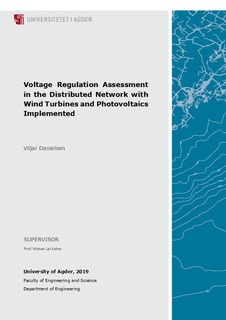| dc.description.abstract | High penetration of Distributed Generators (DGs) in the Distributed Network (DN) could cause undesirable operating conditions. The DN isby conventional means planned, andoperated in a passivemanner, i.e., the level of monitoring is low, and the power flow ispredicted in order to provide satisfactory power quality at the customer’s Point of Common Coupling (PCC). However, the implementation of DGs based on intermittent renewable energy sources, such as Photovoltaics (PV) or Wind Turbines (WT) stress the existing voltage regulation scheme in the DN. One of the objectives of the Distribution System Operators (DSO) is to providevoltage levels withinadmissiblelimitsat all PCCs, and thus, the impact of DGs inthe DN, and strategies for mitigating problems, if present, is of interest. The main aim of this paper is to inspect the impact of DG integration in the DN, with respect to voltage levels. In particular, the steady-state conditionsthrough the course of a dayare studied, in balanced system. The assessed types of DGs are considered to be PV in the Low Voltage (LV) grid, and WT (one Wind Farm) in the MV network. Firstly, some basic load-flow simulations were performed on a radial MV network with three feeders, illustrating the impact of DG in a generic manner. Simulations were conducted by applying load curves and PV generation curvesin a LV network. No novel approach of voltage regulation has been introduced in this paper, however, the strategy of applying On-Load Tap Changer (OLTC) technology on the MV/LV Transformer (TF), by using apparent power measurement for determining the desired voltage setpoint, was briefly introduced. Furthermore, evaluating reactive power control by operating the PVs in a cabled LV network at constant Power Factors (PF) was performed. The Fully rated converter WTs ability to provide reactive power support and its impact on network voltage was briefly assessed. The main findings of the work conducted; was the serious voltage rises recorded in all systems, when DG was introduced. In a MV network; a maximum voltage of 1.04 p.u. was recorded in the Low Load High Production (LLHP) scenario, thus it was close to the limit considered admissible in this work. The high voltage was recorded to be the result of DG injecting power into the grid. A Wind Farm implemented in the MV network was found to have a major impact on voltage level on the respective feeder. This yielded voltage levels in a connected LV grid to be pushed out of permissible limits, thus breaking regulations in steady-state. Fairly low penetration of PV (19.25 %) was reported to have negative effects on voltage and mitigating further penetration growth when clustered to the LV feeder end. However, if clustered near the TF, a high hosting capacity was observed. The high R/X ratio in the LV grid was recorded to suppress the impact of constant PF control, as the maximum voltage profile improvement was 0.03 p.u. when penetration was 52.25 %. However, the maximum reactive power flow seen by the TF was in such a case increased by 115 %, provoking considerations towards TF overloading necessary if integrating const. PF control of PVs in LV networks. | nb_NO |

